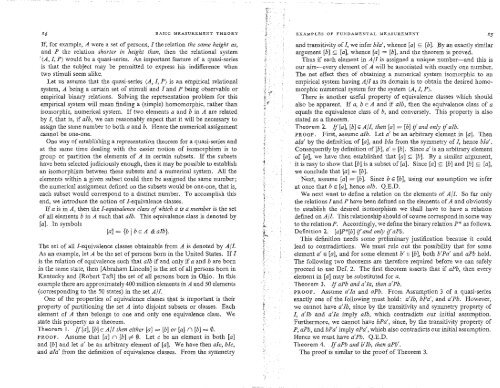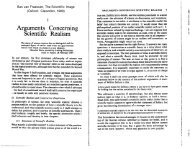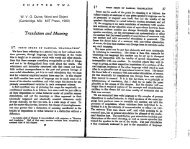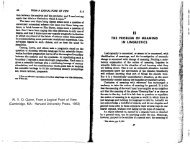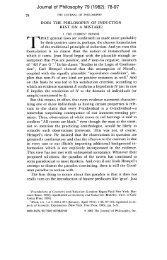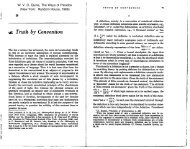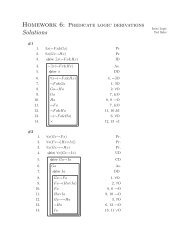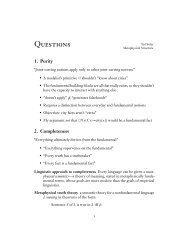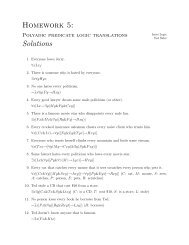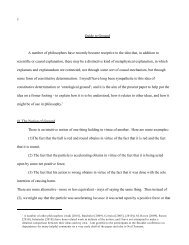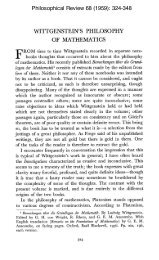Suppes and Zinnes - basic measurement theory.pdf - Ted Sider
Suppes and Zinnes - basic measurement theory.pdf - Ted Sider
Suppes and Zinnes - basic measurement theory.pdf - Ted Sider
Create successful ePaper yourself
Turn your PDF publications into a flip-book with our unique Google optimized e-Paper software.
24 BASIC MEASUREMENT THEORY<br />
If, for example, A were a set of persons, I the relation the same height as,<br />
<strong>and</strong> P the relation shorter in height than, then the relational system<br />
'(A, I, P) would be a quasi-series. An important feature of a quasi-series<br />
is that the subject may be permitted to express his indifference when<br />
two stimuli seem alike.<br />
Let us assume that the quasi-series (A, I, P) is an el'npirical relational<br />
system, A being a certain set of stimnli <strong>and</strong> I <strong>and</strong> P being observable or<br />
empirical binary relations. Solving the representation problem for this<br />
empirical system will mean finding a (simple) homomorphic, rather tl1an<br />
isomorphic, numerical system. If two elements a <strong>and</strong> b in A are related<br />
by I, that is, if alb, we can reasonably expect thatit will be necessary to<br />
assign the same number to both a <strong>and</strong> b. Hence the numerical assignment<br />
cannot be one-one.<br />
One way of establishing a representation theorem for a quasi-series <strong>and</strong><br />
at the same time dealing with the easier notion of isomorphism is to<br />
group or partition the elements of A in certain subsets. If the subsets<br />
have been selected judiciously enough, tl1en it may be possible to establish<br />
an isomorphism between these subsets <strong>and</strong> a numerical system. All the<br />
elements within a given subset could then be assigned the same number;<br />
the numerical assignment defined on the subsets would be one-one, that is,<br />
each subset would correspond to a distinct number. To accomplish this<br />
end, we introduce the notion of !-equivalence classes.<br />
If a is in A, then the [-equivalence class of which a is a member is the set<br />
of all elements b in A such that alb. This equivalence class is denoted by<br />
[a]. In symbols<br />
[a]= {b j bccA &alb}.<br />
The set of all [-equivalence classes obtainable from A is denoted by Ajl.<br />
As an example, let A be the set of persons born in the United States. If I<br />
is the relation of equivalence such that alb if <strong>and</strong> only if a <strong>and</strong> b are born<br />
in the same state, then [Abraham Lincoln] is the set of all persons born in<br />
Kentucky <strong>and</strong> [Robert Taft] the set of all persons born in Ohio. In this<br />
example there are approximately 400 million elements in A <strong>and</strong> 50 elements<br />
(corresponding to the 50 states) in the set A/I.<br />
One of the properties of equivalence classes that is important is their<br />
property of partitioning the set A into disjoint subsets or classes. Each<br />
element of A then belongs to one <strong>and</strong> only one equivalence class. We<br />
state this property as a theorem.<br />
Theorem I. if[a], [b] E A/I then either [a] = [b] or [a] n [b] = f/J.<br />
PROOF. Assume that [a] n [b]""' f/J. Let c be an element in both [a]<br />
<strong>and</strong> [b] <strong>and</strong> let a' be an arbitrary element of [a]. We have then ale, bic,<br />
<strong>and</strong> ala' from the definition of equivalence classes. From the symmetry<br />
EXAMPLES OF FUNDAMENTAL MEASUREMENT<br />
<strong>and</strong> transitivity of I, we infer bla', whence [a]


